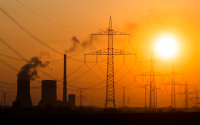13 December 2005Science Daily
New simulations of 21st-century climate show that human-produced changes in land cover could produce additional warming in the Amazon region comparable to that caused by greenhouse gases, while counteracting greenhouse warming by 25% to 50% in some midlatitude areas. The simulations from the National Center for Atmospheric Research (NCAR) show the importance of including land cover in computer-model depictions of global change. The results will be published in the December 9 issue of Science.
Lead author Johannes Feddema (University of Kansas) carried out the modeling work with six coauthors from NCAR while on sabbatical at the center. The team linked NCAR's Land Surface Model with the global-scale Parallel Climate Model, developed by scientists at NCAR and the U.S. Department of Energy under DOE sponsorship. This marks the first time a simulation of 21st-century warming includes not only interactive ocean and atmosphere components but also changes in land cover caused by agriculture, deforestation, and other human activities.
"The choices humans make about future land use could have a significant impact on regional and seasonal climates," says Feddema.
Taken together, the impacts of greenhouse gases around the globe should far outweigh the regional effects of land-cover change, according to Feddema. However, the regions with extensive agriculture and deforestation also tend to be highly populated, so the effects of land-cover change are often focused where people live.
"Compared to global warming, land use is a relatively small influence. However, there are regions where it's really important," he says.
To bracket a range of possibilities, the group examined two contrasting scenarios for greenhouse emissions and land cover put forth by the Intergovernmental Panel on Climate Change. The more pessimistic scenario assumed that emissions will increase steadily, while the more optimistic scenario assumes rapid gains in energy efficiency.
The results for the first scenario show that deforestation adds 2°C (3.6°F) or more to surface temperature across the Amazon by 2100. Cooling occurs in the nearby Pacific and Atlantic waters with a weakening of the large-scale Hadley circulation that drives tropical and subtropical climate. In turn, moisture penetrates further north and produces a cooling, moistening influence across the U.S. Southwest during that region's summer monsoon.
While deforestation acts to warm the tropics by replacing forests with less productive pasture, converting midlatitude forests and grasses to cropland tends to act as a cooling influence, because the crops tend to reflect more sunlight and release more moisture into the air. Feddema and colleagues found that expanded agriculture tends to counteract global warming by as much as 50% across parts of North America, Europe, and Asia. In Canada and Russia, boreal forests add to regional warming as they spread north over time.
Although the two IPCC scenarios studied agree on the impacts of land use in some regions, they produce contrasting results in others. The next step for Feddema and colleagues is to utilize the NCAR-based Community Climate System Model, which will provide higher-resolution results. They also hope to incorporate the effects of urban areas on regional climate.
"Our results suggest that more research efforts should be devoted to producing viable scenarios of land-cover change in the future," says coauthor Linda Mearns, director of the NCAR Institute for the Study of Society and Environment. "We very much hope that other climate modeling centers perform experiments similar to ours."
"The purpose of our project is to include human processes more directly in global climate models," adds Feddema. "This is the first step."
The simulations were supported by the DOE, the National Science Foundation, and the University of Kansas. NSF is NCAR's primary sponsor. Opinions, findings, conclusions, or recommendations expressed in this publication do not necessarily reflect the views of NSF.






